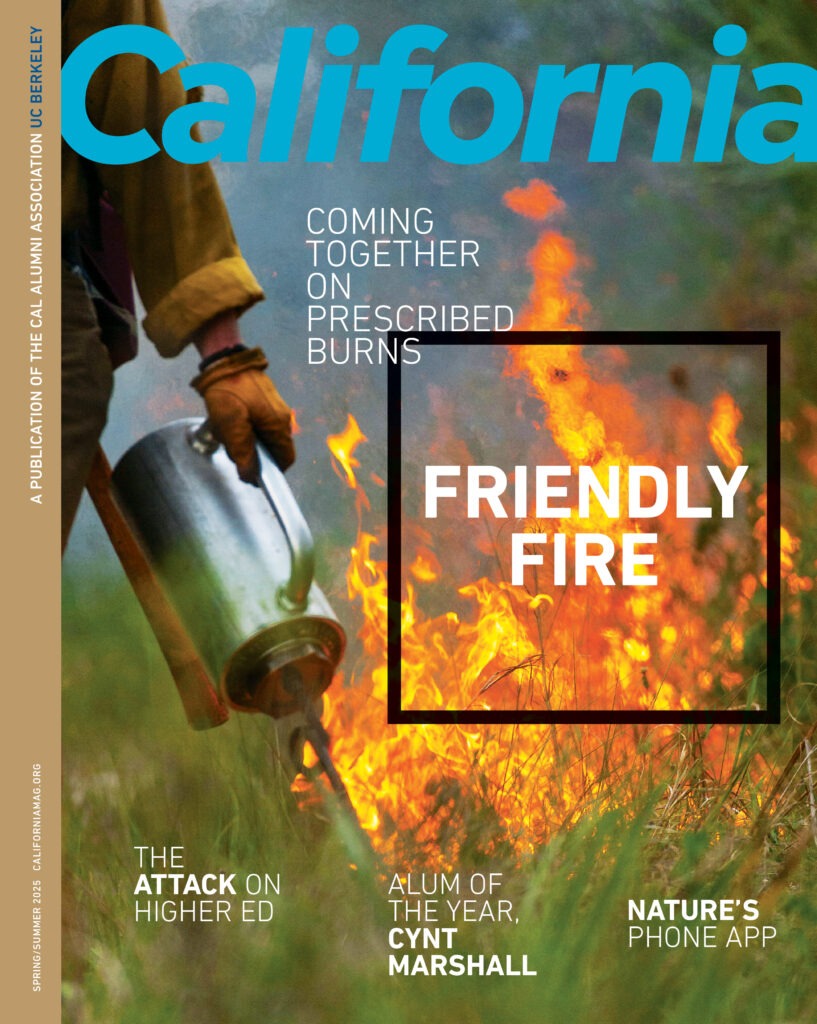
Alums Lenya Quinn-Davidson (left) and Katie Low (center), and ESPM professor Scott Stephens are a few of the faculty and alumni working with UCANR’s Fire Network to help California communities respond to the state’s growing wildfire crisis.
Historically, forests across California looked radically different from how they do today. Many were dominated by large pine species and had substantially fewer small trees, shrubs, and plants living on the forest floor—conditions that made them better suited to withstand long-term drought and wildfire.
Much of this can be attributed to the active role that California’s Indigenous people played in stewarding the land, either by burning away the organic matter that allowed fire to spread or by letting natural fires run their course. Forest composition dramatically shifted once the state began aggressively suppressing any instance of fire, and over the past century, wildfires have grown more destructive and harder to contain.
UC Berkeley faculty and Rausser College of Natural Resources-trained foresters and fire ecologists have been working for decades to better understand changing forest conditions and help communities respond to the state’s growing wildfire crisis. They’re now helping lead UC Agriculture and Natural Resources’ statewide Fire Network, which links experts on fire ecology, forest resilience, and land management to the more than 7 million Californians living in some of the state’s most fire-prone regions.
“Fire is the most powerful tool we have as a species,” Fire Network director Lenya Quinn-Davidson (BS ’04 Conservation and Resource Studies) told California magazine in their June issue. “Fire feels good. It brings people together. It’s something we cook over. It’s something that warms us. It’s just very human. And I think for so long we’ve disconnected from it.”

A story about the UCANR Fire Network was featured on the cover of the Spring/Summer 2025 issue of California magazine.
Quinn-Davidson studied watershed restoration as a UC Berkeley undergraduate, but credits Professor Scott Stephens, one of the leading experts in fire ecology, with sparking her interest in using prescribed fire as a forest management tool. That fascination inspired her master’s thesis at Humboldt State and her career as a UCANR Cooperative Extension fire advisor for California’s North Coast and director of the Northern California Prescribed Fire Council.
Now, Quinn-Davidson works alongside a half-dozen advisors embedded in fire-prone counties, offering guidance on everything from conducting prescribed burns to evacuation planning and making homes less likely to ignite during a wildfire. Much of the network’s efforts are linked to the work of Cooperative Extension specialists like UC Berkeley’s Kristen Shive and Rob York, who conduct research and also share it with affected communities. Katie Low (BA/BS ’20 Geography and Ecosystem Management and Forestry, MF ’22 Forestry) serves as coordinator for the network, developing educational materials and leading virtual training. Alums Kane Russell (BS ’20 Ecosystem Management and Forestry, MF ’21 Forestry), Ricky Satomi (BS ’09 Forestry and Natural Resources and Society and Environment, MF ’16 Forestry), and Cleo Woelfle-Hazard (PhD ’15 Energy and Resources Group) are all UCANR fire advisors affiliated with the network as well.
Development of the network dates back to 2017, when Stephens and William Stewart, both faculty members in the Department of Environmental Science, Policy, and Management, urged California legislators to support and invest in community-level approaches, focusing on expanding ANR’s fire extension program. Initial funding for the Fire Network was approved in 2021, and Quinn-Davidson—then a Cooperative Extension fire advisor for California’s North Coast—was appointed as Director two years later.
The network also supports more than two dozen Prescribed Burn Associations across California, assisting thousands of community volunteers who conduct prescribed burns to restore habitat and to make their homes and communities more resilient to future fire.
Learn more about the Fire Network and read the full cover story in California magazine.
